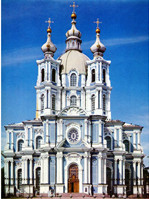
The Resurrection of Christ the Savior Cathedral (Smolny Cathedral) was founded
On October 30 (November 10) 1748 in St. Petersburg to the design of the architect Francesco Bartolomeo Rastrelli was founded the Resurrection of the Christ the Savior (Smolny) Cathedral of the Novodevichiy convent.
Having ascended the throne the Empress Elizabeth of Russia (Elizaveta Petrovna) “… in order to provide a peaceful shelter for orphan young girls, who wanted to spend life in seclusion and piety… expressed a will to turn the refuge of her first youth [“Smolny House”] into a convent”.
Construction of the convent ensemble was assigned to an outstanding Russian architect of Italian origin Francesco Bartolomeo Rastrelli. Preparatory works were launched in 1744 and four years later, on October 30 (November 10) 1748 was laid the cathedral’s foundation stone. “Under the Highest Order the Archbishop Simon conducted a service in the Church of the Horse Guards Regiment, went around the Smolny Palace with a cross procession, in the presence of the Empress laid a foundation stone of the new convent, which was given the name of Voskresensky after the Resurrection of the Christ the Savior Cathedral”. The convent’s ensemble is a cross-shaped square, formed by the buildings of monastic cells and a widows’ house, with a cathedral as its centerpiece. Built on the site of the Smolyanoy Dvor (taryard), the convent was called Smolny, though officially it was known as Voskresensky Novodevichiy Convent.
By 1761 the cathedral had been almost completed, however as the Seven Years’ War broke out the construction works slowed down, while after the death of Elizabeth of Russia they came to nought.
In time of the reign of Catherine II convent’s buildings with cells were used to accommodate the Educational Society of Noble Maidens (Smolny Institute), which later moved to another building.
In late 1820s following the instructions of Nicholas I were mounted works targeted at completion of the cathedral, which were only finished in 1832s-1835s under the direction of the architect Vasiliy Petrovich Stasov.
On July 20 (August 1) 1835 the convent was consecrated in the presence of the Emperor Nicholas I, members of his family and top officials. By the imperial order during the consecration the cathedral was called the Cathedral of All Educational Institutions in commemoration of the Empress Maria Feodorovna, widow of Paul I, who used to donate large sums of money to the public education.
After the 1917 revolution most valuable church belongings were confiscated, the cathedral itself was turned into as a warehouse.
In 1974 the cathedral housed the branch of the Museum of Leningrad History, and from 1990 here has been operating a concert and exhibition hall “Smolny Cathedral”.
Today in the Smolny Cathedral you can listen to religious, classical and modern music, enjoy the performance of well-known Russian and foreign musicians, or take part in photo and art exhibitions. Here take place contests and intellectual games for pupils. Along with the eventful concert, exhibition and educational activities, in summer the cathedral always undertakes restoration and modernization works.
Lit.: Длужневская Г. В. Утраченные храмы Петербурга. СПб., 2003; Знаменский С. К. Смольный женский монастырь в С.-Петербурге в 1742–1810 гг. СПб., 1904.
Based on the Presidential Library’s materials:
Полное собрание законов Российской империи, с 1649 года. Т. 12 (1744-1748). 1830. № 9546. С. 914;
Снессорева С. И. С.-Петербургский первоклассный общежительный женский монастырь. Ч. 1. СПб., 1887.

